HE-560
back to HIFIMAN
back to measurements
home
Published: Jul-18-2017, updated May, 2-2021
NO SMOOTHING is applied to the shown plots. Most measurement sites have some smoothing applied which ‘irons flat’ sharp peaks and ‘wiggles’. I do not use smoothing because some info about sound quality is lost when plots are smoothed.
Aside from a small correction of the microphone itself also some correction in the lowest frequencies is applied to the plots to compensate for the perceived loss of bass when using headphones. This is described HERE in more detail.
A ‘horizontal‘ frequency response curve on the shown frequency response plots on this website thus indicates a perceived ‘flat’ tonal signature.
ALL measurements are made with a good SEAL on a flatbed measurement rig.
The shape of your head, bone structure, pad size, pad ‘softness, (compliance), hair or no hair and or wearing glasses may (drastically) change the frequency response of some headphones, so… your personal experience may differ substantially from these plots.
Frequency response (tonal balance) is the most sound-determining aspect of headphones. A horizontal line shows audible neutral response in the plots on this website. Deviations in different severities at different frequency bands have an effect on the sound character.
The bigger the deviation the stronger the effect.
Below an aid to help determining the sound character of headphones with relation to the frequency response.

HIFIMAN HE-560 v2
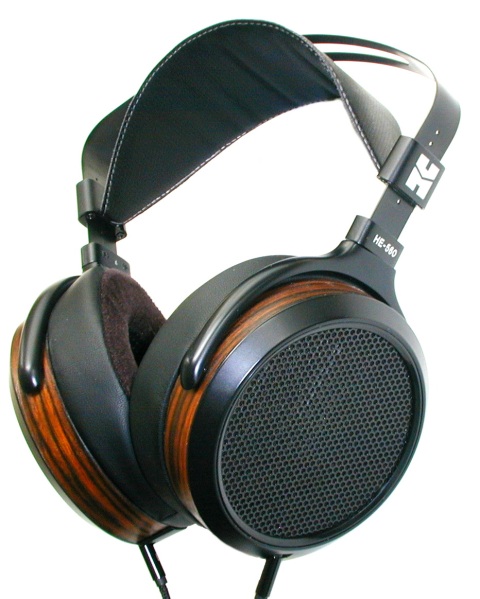
The HIFIMAN HE 560 v2 is a planar magnetic over-ear headphone. It retails for around € 900.- which is quite expensive for a headphone. The fact that much more expensive headphones exist doesn’t turn this headphone into a relative bargain. The pads look and feel luxurious, the wood looks very nice combined with the black accents.
Despite its low impedance this headphone isn’t designed to be driven from portable equipment. The fact that it comes with a 6.3mm TRS plug and not a 3.5mm one is also testimony to that. The efficiency is low and thus needs amplification.
The driver impedance for the measured HE560 was 57Ω instead of the listed 45Ω. I also had a HE560 driver here that measured 34Ω so obviously not all HE560 drivers are created equal. The measured headphone (with 57Ω impedance) did have the same impedance drivers.
Comfort is excellent, because of the large pads the pressure is well distributed and ensures a good seal which is not essential for this headphone by the way.
The weight of this planar headphone is low compared to ‘similar’ headphone types. This is largely due to the way the drivers are built with single sides magnets.
Everyone around you can hear what you are playing and you can hear all ambient noises unattenuated.
The cable is quite stiff, tangles easily and is cloth covered. It is low in microphonics so when the cable rubs against clothes this isn’t mechanically very audible in the headphone.
The newer HE560v3 and v4 versions do not have the wood cups any more and have a different headband.
specifications:
Type: Over ear, open
Usage: Home
Driver type: planar magnetic, single sided magnets
Driver size: ø 75mm
Pads: 5° angled, replaceable, hybrid pleather/velours (Focus-A)
Inner Pad dimensions: depth = 27mm (front) 30mm (rear), ø 54mm
Fold-able: No, but can rotate the cups in a flat position.
Headphone connector: 2,5mm TRS (marked L and R)
Cable entry: double sided
Cable: replaceable 2m with gold plated 6.3 mm plug.
Nom. power rating: 2W (estimated)
Max. voltage: 10V
Max. current: 210mA
Max. S.P.L.: 119dB
Impedance: 56 Ω (measured)
Efficiency: 86 dB @ 1mW
Sensitivity: 98dB @ 1V
Weight: 375 g.
Clamping force: medium
Sound description:
Bass from the HE560 is punchy. Bass is well extended but not overblown but has some slight ‘woolly’ character to it. The sound is ‘open’ and lacks some and can sound a bit ‘coarse’ with some recordings in the upper mids/lower treble as in not super refined. The mids sound very open and dynamic but has an unnatural/artificial ‘clarity’ to it because of the 2kHz dip followed by somewhat emphasized 4kHz area. Because of the HE560 can sound a little ‘shouty/shrill’ especially with poorer recordings.
measurements:
Below the frequency response of the HE-560 (Left, Right)
A second HE560v2 was also measured. (Left, Right)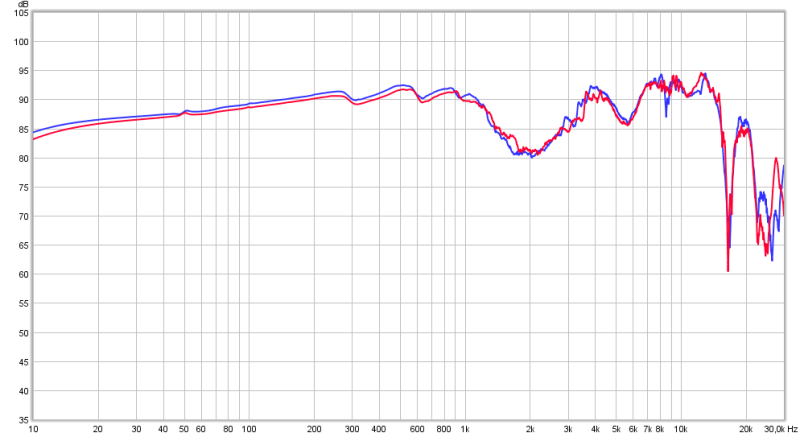 The channel balance of both headphones is excellent, as with most HIFIMAN headphones. The tonal balance is ‘flat’ as in neutral but a bit on the bright side.
The channel balance of both headphones is excellent, as with most HIFIMAN headphones. The tonal balance is ‘flat’ as in neutral but a bit on the bright side.
The 10dB dip at 2kHz lowers some sense of the ‘presence’ of voices a bit. It should be noted that the measurement is done without a pinna. Because of the slight angle of the pads and the pinna gain the area between 1kHz and 5kHz will sound more elevated than shown in the plots. This is potentially bad news for the 4kHz peak which will be even more pronounced. The treble response is just very slightly elevated but certainly doesn’t stand out above the rest. It is well balanced and smooth.
For about half the price you can buy the HE 400i.
Below the differences between the HE-560 and HE 400i are shown. The later HE400 versions have reduced treble.
Basically the HE-560v2 is the ‘fixed’ version of the HE-400i. The tonal balance of the HE-560 is more accurate. Bass extension and ‘flatness’ is better and above all the 8kHz of the HE 400i isn’t there. This makes the HE-560 sound very smooth and real but also more ‘edgy’ because of the elevated 4kHz part.
The tonal balance differences are shown more clearly in the 1/3 octave smoothed plot below. HE-560 and HE 400i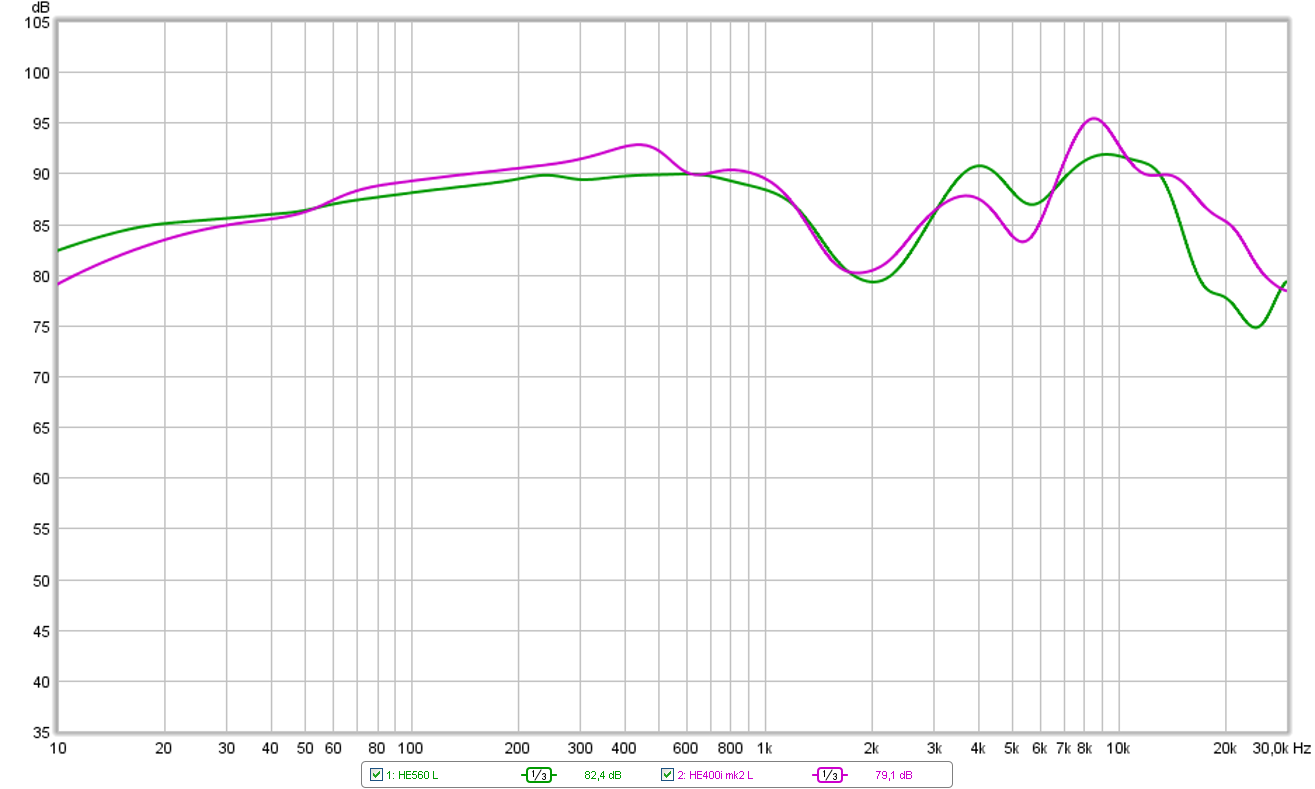
Seal
Seal can be an issue with closed-back headphones. Breaking the seal (improper fit on the head) usually means a loss of (sub)bass. Seal breakage can be caused by different facial contours, glasses or hair between pads and head. Open headphones usually are less seal dependent. This is surely the case with the HE560.
Below the effect of different levels of seal breach are shown .
Perfect seal, Seal broken with a pair of glasses, seal broken using a 6.3mm TRS plug, seal broken by slightly lifting the pads.
Breaking the seal only slightly improves the lowest frequencies . When seal is broken even more the lowest frequencies start to become affected. Wearing glasses has no influence on the tonal balance at all.
output resistance / damping-factor
As this is a planar magnetic headphone its impedance is as good as ruler flat so a higher output resistance amplifier will have no consequences for the frequency response/tonal balance/damping. The 9.9dB level difference when driven from 120Ω source is compensated so tonal balance changes are easily shown. There aren’t any. Driven from a 0.2Ω amp the response is the same. This is not very visible but the red trace is totally hidden behind the green trace. 
Phase response is shown below. (Left, Right)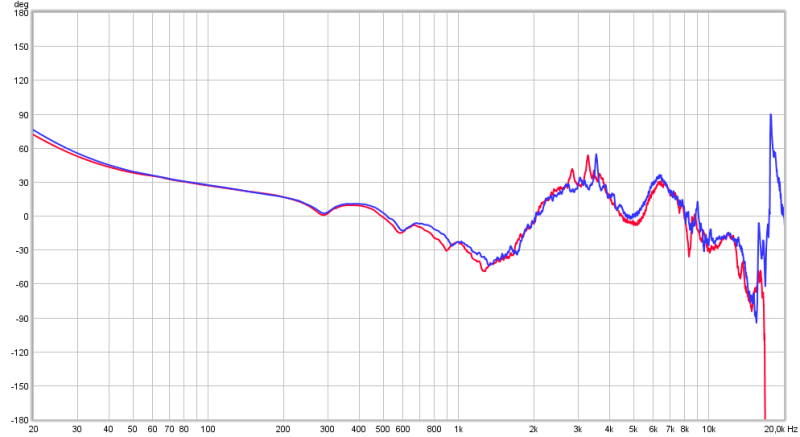 Phase response does not show any ‘sharp’ phase shifts so this is not an issue with this headphone. Only near 20kHz there are some sharp phase shifts.
Phase response does not show any ‘sharp’ phase shifts so this is not an issue with this headphone. Only near 20kHz there are some sharp phase shifts.
Below the Group Delay plot for the HE560 which does not show any ringing issues at all. The peaks around 18kHz are measurement errors that jump position when the headphone is re-seated. (Left, Right)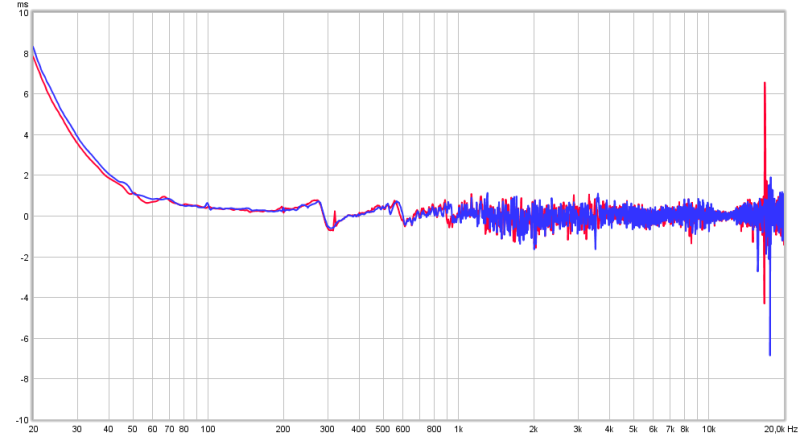
Below the CSD of the HE-560. (Left and Right are superimposed)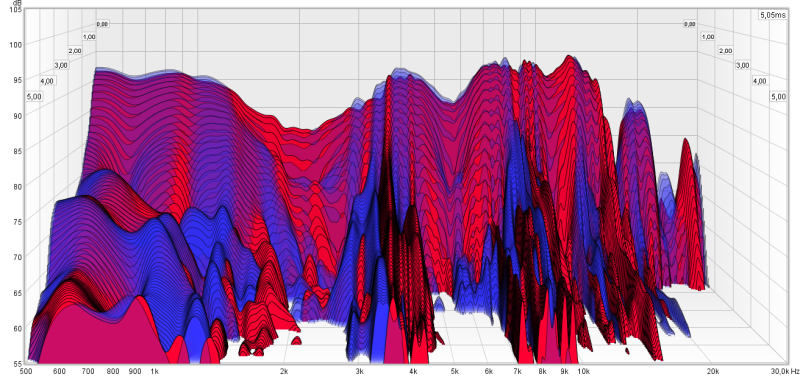
Around 4 kHz, 8kHz and 16kHz there is substantial ringing going on. At 4kHz this is benign as the ear canal resonates at this frequency as well. At 8kHz there is some ringing. This is at the same frequency as the HE 400i and doesn’t seem to be a coincidence. Audeze models perform much better in this aspect.
The step response (Left, Right) below shows the bass is just slightly rolled-off. 
The first resonances are short lived but they do linger on for a long time but low in level. The small dip after the initial impulse flank that reaches 0dB shows the slight lack in ‘presence’ as caused by the 2kHz dip. Impulse response is at the proper level though. The peaking around 300μs is evidence of the ‘sharpness’ in the lower treble.
Below the spectrum plot of the HE-560.  The spurious signals in the upper part above 1kHz of the plot are often seen with planars and open back headphones. At 4kHz and 8kHz the ringing is clearly visible.
The spurious signals in the upper part above 1kHz of the plot are often seen with planars and open back headphones. At 4kHz and 8kHz the ringing is clearly visible.
Below the distortion measurements of the HE-560 (Right channel).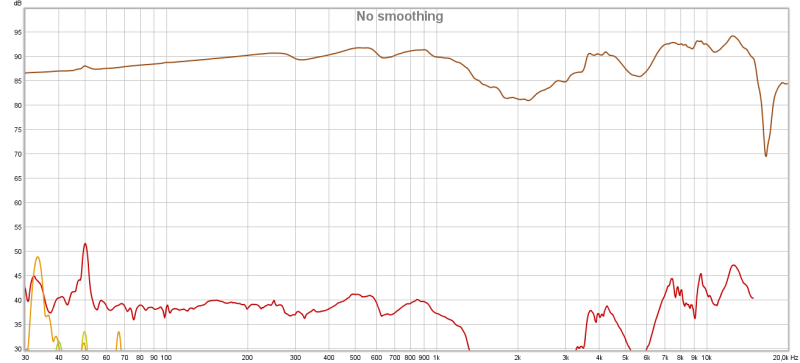
The distortion plot above shows a dB scale. Below the same measurement but in percentage scale.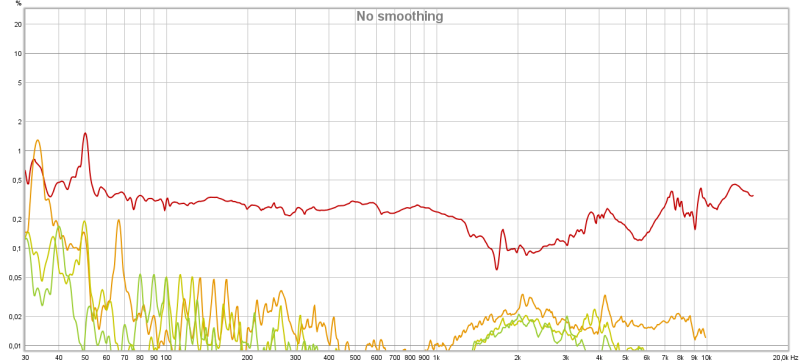 Ignore the 50Hz peak, this is hum being picked up. Distortion is low (measured at 90dB SPL) and what’s shown is the measurement limit of the test fixture so will be lower than shown above. It shows no problem area’s .
Ignore the 50Hz peak, this is hum being picked up. Distortion is low (measured at 90dB SPL) and what’s shown is the measurement limit of the test fixture so will be lower than shown above. It shows no problem area’s .
Given the very low third harmonic distortion levels there is no compression to be expected. Below the compression measurement for the HE560.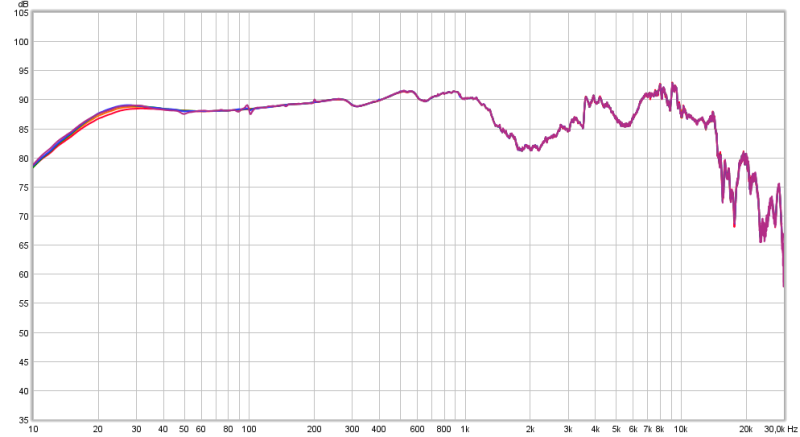 The plot above requires some explanation. The frequency response of the HE560 is measured at 5 different SPL levels.
The plot above requires some explanation. The frequency response of the HE560 is measured at 5 different SPL levels.
60dB, 70dB, 80dB, 90dB and 100dB SPL and then the traces are overlaid by moving the 100dB trace -10dB and moving the lower SPL levels upwards. When the traces overlay the tonal balance does not change with larger excursions (no compression/soft-clipping) at the measured levels. Ignore the wiggles at 50Hz and 100Hz for the lowest levels, this is hum. As can be seen there was a slight seal issue during this measurement. There is some very small compression visible around 25Hz but this is not really audible.
Shrillness filter
When you find the HE560 (Focus A pads) has some shrillness or sounds a bit ‘sharp’ then the filter below can solve this issue. It lowers the 4kHz peak about 4 dB and the upper treble by 2dB. This results in smoother sound without any sharpness.

summary
Fit and finish, comfort, weight (for a planar) are very nice. The wood color scheme looks quite nice and classy. The black accents also work pretty well. The sound signature is full sounding but can be a bit shrill. Clarity of instruments is good but because the 4kHz is elevated a bit emphasized. Treble is smooth, realistic and not splashy nor sibilant at all. A very nice sounding headphone with only some slight niggles. Some EQ or the filter can sure the shrillness.
The low efficiency means this headphone must be connected to a decent amplifier with enough gain and output voltage when you want to play at impressive loud levels. The cable, being stiff and easy tangling is something I would recommend to buy a more supply after-market cable for.
